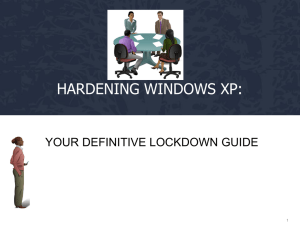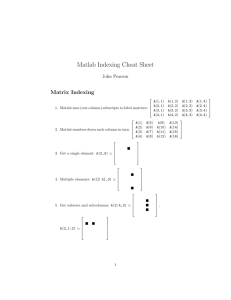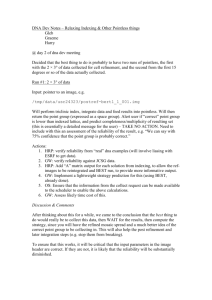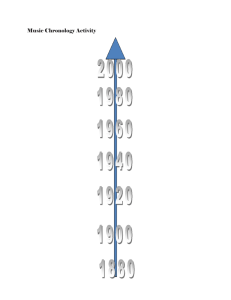Device Drivers
advertisement
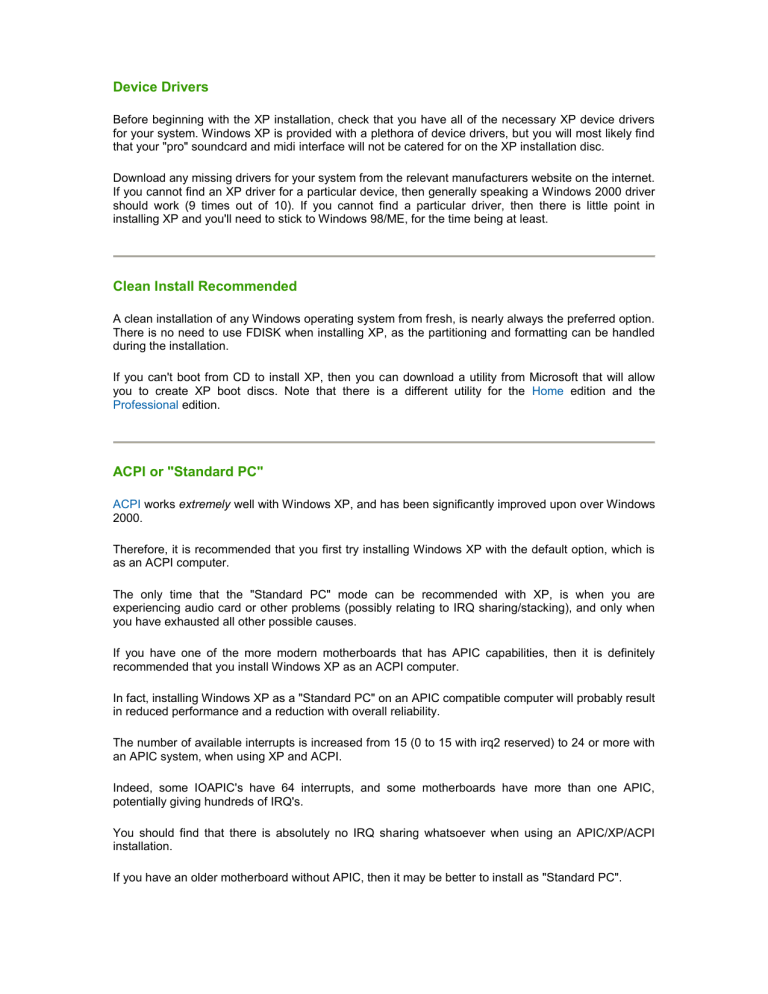
Device Drivers Before beginning with the XP installation, check that you have all of the necessary XP device drivers for your system. Windows XP is provided with a plethora of device drivers, but you will most likely find that your "pro" soundcard and midi interface will not be catered for on the XP installation disc. Download any missing drivers for your system from the relevant manufacturers website on the internet. If you cannot find an XP driver for a particular device, then generally speaking a Windows 2000 driver should work (9 times out of 10). If you cannot find a particular driver, then there is little point in installing XP and you'll need to stick to Windows 98/ME, for the time being at least. Clean Install Recommended A clean installation of any Windows operating system from fresh, is nearly always the preferred option. There is no need to use FDISK when installing XP, as the partitioning and formatting can be handled during the installation. If you can't boot from CD to install XP, then you can download a utility from Microsoft that will allow you to create XP boot discs. Note that there is a different utility for the Home edition and the Professional edition. ACPI or "Standard PC" ACPI works extremely well with Windows XP, and has been significantly improved upon over Windows 2000. Therefore, it is recommended that you first try installing Windows XP with the default option, which is as an ACPI computer. The only time that the "Standard PC" mode can be recommended with XP, is when you are experiencing audio card or other problems (possibly relating to IRQ sharing/stacking), and only when you have exhausted all other possible causes. If you have one of the more modern motherboards that has APIC capabilities, then it is definitely recommended that you install Windows XP as an ACPI computer. In fact, installing Windows XP as a "Standard PC" on an APIC compatible computer will probably result in reduced performance and a reduction with overall reliability. The number of available interrupts is increased from 15 (0 to 15 with irq2 reserved) to 24 or more with an APIC system, when using XP and ACPI. Indeed, some IOAPIC's have 64 interrupts, and some motherboards have more than one APIC, potentially giving hundreds of IRQ's. You should find that there is absolutely no IRQ sharing whatsoever when using an APIC/XP/ACPI installation. If you have an older motherboard without APIC, then it may be better to install as "Standard PC". However, the bottom line is that if you have a working system with ACPI, then leave it alone. If it isn't broken, then don't fix it. To find out if your motherboard has APIC, then please refer to your motherboard manual and/or check in the BIOS. If you want to use APIC, then make sure it is enabled in your BIOS. When installing XP as an ACPI PC on an APIC motherboard, it doesn't matter what the "Plug and Play OS" setting is in your BIOS. XP will override this anyway. Microsoft actually recommend setting this to "No" regardless. If you do decide to install as a "Standard PC", then follow the steps below. Firstly, the entry Plug and Play OS in your motherboard's BIOS should be set to 'NO'. Click here to find out why. During installation of the XP operating system, you will see a screen displaying the message - "Press F6 if you need to install a third-party SCSI or RAID driver". At this point, press the F5 key (this won't be supplied as an option on the screen and the installation won't wait, so you'll need to babysit the installation process and hit the key at the right moment). A few seconds after pressing F5, you will be presented with an option to select either "Standard PC" or "Other (ACPI) PC". At this point, select "Standard PC". If you have already installed XP with ACPI, then you can change to "Standard PC" in the device manager afterwards. However, this method doesn't appear to be as effective as disabling it during the install. To do this, Start > Settings > Control Panel > System > Hardware Tab > Device Manager. Expand the Computer at the top of the list and right click the ACPI Computer > Drivers > Update Drivers > Select List > Standard PC. Note that when you reboot your PC, you will need to re-install all of your device drivers again. Further reading here here How Much Disc Space? When configuring your system disc, bear in mind that XP uses up somewhere in the region of 1.5 2GB of installation space. This is enormous when compared to the 200MB (approx.) required by Windows98SE (when using windows managed dynamic swap file). However, there are a number of ways of reducing the amount of space required by XP after installation. More of this later. Between 3GB and 4GB is the recommended minimum size of disc/partition space required for the XP installation and for any further audio applications. Obviously, if you plan to install any large files on the system disc (Steinberg's The Grand - 1,2GB), then you will need to consider this also. Incidentally, "The Grand" soundfiles will quite happily sit on your audio disc with no problems. A useful tip when configuring your audio disc, is to split this into two partitions. Set up a smaller "audio scratch" partition - say 6GB of a 30GB hard disc. This partition will be used for the songs that you are currently working on. The benefit of a smaller partition is obviously quicker defragmentation. If you use the entire 30GB as one partition, then this will take ages to defragment. When you are finished with a song, transfer the audio files to the non-scratch partition, where disc I/O performance isn't so critical. Motherboard Chipset Drivers Motherboard chipset drivers are usually supplied on a CDROM with the motherboard. However, later versions of these drivers can usually be downloaded from the relevant chipset manufacturers web site, i.e. Intel or VIA. It is certainly worth checking the sites above to see if there have been any new versions released, as problems may have been fixed. If you have an Intel chipset motherboard, then go to http://www.intel.com and for VIA chipset motherboards, get the latest "4-IN-1" drivers from http://www.viatech.com. 1 - Processor scheduling should be set to background services and not Programs. This is a very important tip and could make a significant difference to how low you can set your samples per buffer for your soundcard. A lower samples per buffer setting means lower latency, which is better for vsti's and ASIO monitoring (if you use it). Processor scheduling should be set to background services and not Programs. This has the effect of switching from more frequent and smaller CPU time slices (applications), to less frequent and longer CPU time slices (background services). This allows the audio application or driver to "hang on" to the CPU for longer without interruption. In addition, the background services setting also reduces the amount of "priority boost" that foreground window's threads receive. Start > Settings > Control Panel > System > Advanced > Performance Settings > Advanced Tab > Background Services 2 - Visual effects should be set to a minimum. Like all previous Windows operating systems, there are many graphic effects menu animations, dissolving menus and "tip" pop-up windows that all require additional processing power. For a professional audio system, these "accompaniments" just use additional CPU power and can cause audio glitches due to the additional traffic being generated on the system bus. There are a number of different ways to reduce the number of graphic effects, but it seems that the quickest way to turn off any unnecessary Windows XP animations, is by going to Start > Control Panel, click on Performance and Maintenance (if not using classic view), click on System, select the Advanced page and then click on the Settings button in the Performance section. A window will appear with a Visual Effects page. The default is "Let Windows choose what's best for my computer", which will mean that most graphic options will be highlighted (dependant on computer). Change this to "Adjust for best performance" and this will disable all of the "highlighted" options. When you have done this, the overall GUI look and feel will be more like the "classic" Windows. If you want to speed up the graphics, but want to retain some of the look of the new XP GUI, then after selecting "Adjusting for best performance" - scroll to the bottom of the list and select "use visual styles on windows and buttons". This will give you some of the XP "look", without much processor overhead. 3 - Switch Off Desktop Background Image Switch off the desktop wallpaper as this uses additional graphics memory that can be used elsewhere. Right Click Desktop > Properties > Desktop Tab > Background None 4 - Disable Screen Saver Contrary to many popular audio tuning articles, disabling the screen saver is really not necessary with an audio PC. A screen saver is only ever activated once - when the screen saver is activated. Cycles aren't magically taken from your CPU, while your audio application is running if your screen saver is switched on. Indeed, I would even say that it is more important to leave the screen saver switched on, as even modern CRT monitors can develop "burn in". Even LCD/TFT monitors are susceptible to fatigue. It is probably better to increase the Wait time to a sensible value, rather than to disable the screensaver altogether. However, if you do want to turn off the screen saver, do this as follows. Right Click Desktop > Properties > Screen Saver > None 5 - Disable Fast User Switching There is a completely new function in both the Home and Professional versions of Windows XP,called "Fast User Switching". While one user is logged on, another can logon without having to log off the first user. The applications that the first user started will keep running in the background so that he/she can continue where they left off - once the second user logs off again. This is a very clever and potentially useful feature for companies where more than one person may require access to the PC at the same time, without having to constantly log on and off for each user. However, this is not really a useful feature for a dedicated audio system. So, disable this feature by going to Control Panel and under "User Accounts", select "change the way users log on or off" and then disabling "fast user switching". Remember to click on Apply Options. Note that this will not affect the ability to log on as different users. The difference that this will make is that one user has to log off completely before another logs on. This will stop additional programs staying resident in memory for multiple users. Note that this feature can always be turned back on again if required. Windows XP will automatically disable this feature if there is 64MB or less of RAM. 6 - Switch Off Power Schemes Open the "Power Options" applet of Control Panel and set Power Schemes to "Always On, Turn Off Monitor to "Never" and Turn Off Discs to "Never". If your BIOS supports it, also consider deactivating power management in the BIOS too 7 - Switch Off Hibernation Windows XP by default creates a file called hiberfil.sys, to store the contents of RAM in the event of the computer automatically going into "hibernate" mode. The size of this file will be determined by the amount of RAM you have installed in your system. If you have 512MB RAM, then a file of 512MB will be created. If you have 1GB of memory, then a 1GB hibernation file will be created. This is not required for an audio PC, regardless of whether or not ACPI is activated or not, so in the Power Options applet in the Control Panel, click on the Hibernate page and untick the "Enable Hibernation" box. This will immediately free up this space on your disc 8 - Activate DMA on Hard Discs/CD ROMS By default, slave drives on ATAPI channels are often set to PIO mode, even when the attached device is capable of much more efficient UltraATA (DMA) mode data transfers. This can hurt the performance of the affected devices. Also, DMA mode data transfer, places less overhead on the CPU than PIO mode. Open Device Manager and expand the entry labeled - "IDE ATA/ATAPI Controllers". Right click each IDE channel entry and select the Advanced Settings Page. Check that the Transfer Mode is set to "DMA if available" for all channels. 9 - Disable System Sounds This is a very important tip. If system sounds is left switched on, then it is possible that this could interfere with your sound card and/or sample frequency settings. Some XP media sounds have been sampled at 20khz(to conserve disc space?) and if these are triggered during playback or recording in your sequencer, then the audio may slow down and adjust to the lower sampling frequency. There are other things that can go wrong with system sounds, so the best bet is just to disable them. Select Control Panel and then the "Sounds and Audio Devices" applet. Click on the Sounds tab and change the sound scheme to "No Sounds". When asked to save current theme, just say no, unless you want to recall it later. 10 - Do Not Map Through Soundcard Applications may still try to play sounds through your "pro" soundcard, so it is recommended that you disable this. Go to Control Panel > Sounds and Audio Devices > Hardware Tab > (highlight your soundcard from the list) > Properties > Audio Devices > (highlight your soundcard from the list) > Properties, and check the "Do not map through this device" checkbox. 11 - Disable System Restore This is similar to the same feature that first appeared in Windows ME, although it has been enhanced slightly in XP to provide more specific restore points, i.e. specific drivers rollback. Basically, it lets you rollback XP to a previous state if there is a system problem, i.e. if you have installed a bad soundcard driver or software update and your system doesn't work properly. This function requires continual monitoring of hard disc activity, and runs (by default) automatically in the background. In many respects, this is probably a useful function to have turned on, although it does use a small amount of added CPU and it creates additional disc I/O. If your system is working as you like it with it turned on, then perhaps you may wish to leave it turned on. If you do decide to leave it on, then it may be worth checking that the frequency of the checkpoint is set to 24 hours (as shown below), and not every two minutes like some people have experienced. Another option would be to leave it turned on for your system disc and switch it off completely on your audio disc(s), as there should be no drivers or programs on your audio disc(s) to be restored. Set the checkpoint to be once per day by setting the registry key below to decimal value 86400 (number of seconds in a day). Start > Run > regedit 12 - Disable Automatic Updates This is where XP will automatically check on the internet for Microsoft updates or service packs for XP. This is a function that I would consider to be better as a manual process. Switch off Automatic Updates by going to Control Panel, System, Automatic Updates and ticking the box labelled "Turn off automatic updating. I want to update my computer manually.". 13 - Startup and Recovery Options If you're computer crashes, and you get the "blue screen of death", then you really could do with seeing and noting down the hexadecimal numbers on the screen before XP reboots. These numbers are useful for diagnostic purposes, Right click My Computer and click on Properties > Advanced > Start Up & Recovery Settings and uncheck "Automatically Restart". 14 - Disable Error Reporting Whenever operating system or program errors occur, Windows XP generates a file containing the errors and offers to send this to Microsoft so that they can "help improve future products". If you don't have an internet connection or if you don't want this functionality, then you can disable it as shown below. Start > Settings > Control Panel > System > Advanced TAB > Error Reporting > Click the Disable Error Reporting box (Tick the "But Notify Me When Critical Errors Occur" if you prefer) 15 - Disable Remote Assistance Using an internet connection, anyone else running XP can chat with you, view your screen, and with your permission, use your computer. If you don't need this feature, then turn it off as described below. Start > Settings > Control Panel > System > Remote > Untick "Allow Remote Assistance Invitations to be sent from this computer" 16 - Fix Swap File (Virtual Memory) This is another tip from previous Windows operating systems, that is still relevant in XP. It is slightly better to have a fixed swap file, rather than to let Windows manage the file dynamically. It is also better to set this up just after installation as the file will be near the start of the disc and will be in one contiguous block. If the installation process hasn't already done so, set the Virtual Memory to be a fixed sized for both the minimum and the maximum values. To do this, select the Advanced tab of the Systems applet and then select the Performance settings button. Then select the Advanced page. In here it is possible to customise the Virtual Memory. For custom size, this is often recommended to be 1.5 to 2 times the amount of your total RAM for both initial and maximum size. Set this to a fixed minimum and maximum value according to your existing RAM. Of course, if you have >512 or >768 MB of RAM, then you could consider disabling virtual memory completely, although I would suggest that you experiment to find out what is best for you. The XP swap file is called pagefile.sys. By default, this will be on your C: drive in the root directory. If you can't see this file in explorer, then this will probably be because the "Hide Protected Operating System Files" option is active in the folder options. To disable this option and make the pagefile.sys visible, start explorer > Tools > Folder Options > View > untick "Hide Protected Operating System Files". Finally, click Yes when asked "Are you sure you want to display these files". If you want to clear your swap file on shutdown, then do the following: 1. Start -> Run -> "secpol.msc" 2. Go to "Local Policies" -> "Security Options" 3. Double click on "Shutdown: Clear virtual memory pagefile" and enable it. 17 - Speed Up Menus You can use this tip to speed up the Start Menu in Windows XP. You can customize the speed of the Start Menu by editing a Registry Key. Click Start, and then click Run. Type Regedit in the box, and then click OK. Expand the menu in the left panel and select the HKEY_CURRENT_USER\Control Panel\Desktop folder. Scroll down in the right panel and double click on the MenuShowDelay file. In the Value Data box, change to default value for the menu speed from 400 to a lesser number, such as 1. Click OK. 21 - Disable Hide Inactive Icons This isn't really a performance tip - more of an irritation. I prefer to manage my own desktop icons. Disable as shown below. Start > Settings > Taskbar and Start Menu > Taskbar TAB > Uncheck "Hide Inactive Icons" 22 - Disable Automatic Desktop Cleanup Wizard Every 60 days, this will run and display a list of icons that have not been used for 60 days or more. It will give you the option to remove those icons that you don't require. If you don't require this functionality, then disable it as shown below. Start > Settings > Control Panel > Display > Desktop > Customise Desktop > Untick "Run Desktop Cleanup Wizard every 60 days" 23 - Disable NTFS Last Access Time Logging (NTFS File Systems Only) With NTFS volumes, Windows XP updates the last access timestamp every time it accesses the hard drive. This can cause a significant decrease in performance. This can easily be disabled as shown below. Start > Run > regedit > HKEY_LOCAL_MACHINE > SYSTEM > CURRENTCONTROLSET > CONTROL > FILESYSTEM Add a new DWORD value - "NtfsDisableLastAccessUpdate" (without quotes) and set the value to 1. Then reboot to make changes effective. 24 - Disable Notification Area Balloon Tips More of an irritation than a performance tip. Click Start , click Run , type regedit , and then press ENTER. HKEY_CURRENT_USER\Software\Microsoft\Windows\ CurrentVersion\Explorer\Advanced Right-click the right pane, create a new DWORD value, and then name it EnableBalloonTips . Double-click this new entry, and then give it a hexadecimal value of 0 . Quit Registry Editor. Log off Windows, and then log back on. 25 - Disable CDROM Autoplay One of the very important (and well documented) tweaks in Windows 98SE, was to disable CDROM autoplay (auto insert notification). Disabling CDROM autoplay no longer offers a significant performance benefit in Windows XP, and therefore you do not need to disable it. Just don't insert a CD during a crucial recording. However, if you really want to disable it then here a few different methods. Method 1 Start > Run > Regedit HKEY_LOCAL_MACHINE\System\CurrentControlSet\Services\Cdrom Set autorun to 0. Method 2 Open My Computer Right Click on each CDROM and choose Properties Click on the Auto Play tab In the drop down box you can choose the Action for each choice shown in the drop down box Method 3 Go to Start->Run->gpedit.msc Computer Config -> Administrative Template -> System Double click Turn off Autoplay Enable it. 26 - Disable Disc Indexing Service Text below taken from XP help. Indexing Service is a service that extracts the information from a set of documents and organizes it in a way that makes it quick and easy to access that information through the Windows XP Search function, the Indexing Service query form, or a Web browser. This information can include text from within a document, (its contents), and the characteristics and parameters of the document, (its properties), such as the author's name. Once the index is created, you can search, or query the index for documents that contain key words, phrases, or properties. For example, you can query all documents containing the word "product" or you can query for all Microsoft Office documents written by a specific author. Indexing Service returns a list of all documents that meet your search criteria. For information on the different ways to create a query, see Using the Indexing Service query language. Indexing Service uses a document filter to read through a document and extract text and properties to pass to the indexer. This process is called indexing. Indexing Service automatically stores all the index information in the System or the Web catalogs. Indexing Service can index the following types of documents in several languages: HTML Text Microsoft Office 95 and later Internet mail and news Any other document for which a document filter is available Indexing Service is designed to run continuously and requires little maintenance. After it is set up, all operations are automatic, including index creation, index updating, and crash recovery if there is a power failure. Text below taken from http://windowsassistance.tripod.com/winxp/search/indexing-service.htm The indexing of files is done whenever the computer is idle. When Windows XP is installed the Indexing Service is setup and two catalogs are created: System and Web. The Web catalog is created if IIS is installed. The problem is what directories are included in the System catalog. When the System catalog is created all permanent storage devices are included. This means if you have 5 partitions then the system catalog will have C:\, D:\, E:\, F:\, an G:\ directories. This could involve a lot of wasted indexing. Therefore you should fine turn the System catalog to better fit your environment. The Actual Steps To Adjust The Indexing Service note: To make any changes to the Indexing Service you must be using an account with Administrator rights. You can use the Indexing Service from any account. We found that the easiest way to open indexing service is from Search->Preferences->Add/Remove Index Service->Change Indexing Service Settings. When the Indexing Service opens you will see one or two catalogs. We will be working with the System catalog only. Double-click the System catalog. Double-click Directories. We now have a list of directories that are either included or excluded from indexing. You can delete existing directories or change their properties. Basically you can include or exclude the directory from indexing. You can also add a directory. Adding and modifying a directory use the same form. To add a directory go to Action menu -> New -> Directory. For each directory that you include or exclude, all of its subdirectories are also included or excluded. To delete a directory: Select the directory and delete. To modify a directory listing double-click the directory. That's really all you need to know to use the Indexing Service. At a minimum you can leave it as it is and search away. Enabling NTFS Partitions For Indexing If you are unable to index a NTFS partition go to the properties page for the partition by opening Windows Explorer, right-clicking the partition, select properties and check Allow Indexing Service to index this disk for fast searching. Further reading : Indexing Service in XP Help Removel of unneeded items One of the features that XP doesn't offer that Windows 98SE did, is the ability to customise the installation process by selecting/removing only the components that you require (Accessories, System Tools, Multimedia, etc.). Windows XP doesn't offer you this flexibility during the installation process, and so any Windows XP components that are not required will need to be removed after the installation has completed. You won't gain any system performance by removing unused components, although you will steal back some disc space and "trim down" your XP environment by removing programs that you just don't use. Normally, to do this you would go to the "Add or Remove Programs in the Control Panel and select "Add/Remove Windows Components". This process scans your system and shows you what you have installed so that you can deselect/delete the programs that you don't need. There is a slight problem, in that Windows XP "hides" certain components so that they can't be seen on the list and subsequently, can't be removed. However, there is a very simple way to make these reappear so that they can be removed. Use Notepad to edit the sysoc.inf file in the Windows/Inf folder. Do a search and replace for the word "hide" (leave match case unticked), replacing hide with nothing. Save the file. TIP : If you can't see the "inf" folder, then in explorer make sure you click the "Show Hidden Files and Folders" option. Explorer > Tools > Folder Options > View. Go back to "Add or Remove Programs in the Control Panel and select "Add/Remove Windows Components". Components that couldn't be seen before can now be viewed and removed. You will notice that Windows Messenger can now be removed, which can be a resource hog. Reboot after removing components to take effect. Typical components that can be removed are (there may be others depending on your requirements): Accesibility Options Indexing service Update Root Certificates Windows Automatic Updates Windows Messenger Games Desktop Wallpaper Explorer (Unless you use the audio PC for surfing of course) Communications MSN Explorer Microsoft Power Toys Power Toys are additional programs that Microsoft developers work on after a product has been released to manufacturing. Microsoft has taken great care to ensure that Power Toys operate as they should, but they are not part of Windows and are not supported by Microsoft. For this reason, Microsoft Technical Support is unable to answer questions about PowerToys. Download the XP versions of Powertools from Microsoft MSCONFIG As with other Windows versions, programs can be started automatically by XP. It is worth checking to see what programs (if any) your XP system is starting by itself on startup, as these may be using valuable processing power. To investigate the automatically starting programs, use the XP msconfig tool. The msconfig tool is not new to XP and first appeared in Windows 98 and then ME. To run msconfig, click on Start > Run and type in "msconfig" (no quotes) and click OK. Click on the Startup Tab and uncheck any programs, that you don't want to autostart. Dont' disable anything you're not sure about. שירותים נוספים לביטול Automatic Updates - disabled Background Intelligent Transfer Service - disabled)(מחשבים ללא רשת Error reporting service - disabled Fast user switching compatibility - disabled Help and support - disabled Human interface device access - disabled Messenger - disabled Netmeeting remote desktop - disabled Print spooler - disabled במידה ואין מדפסתRemote Desktop - disabled Remote registry - disabled TCP/IP Net bios helper - disabled
